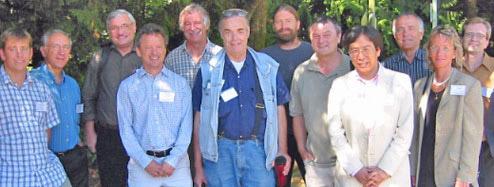
Many years after the last neutrons from the TRIUMF 4C neutron beam passed down the collimator, scientists are considering bringing back neutrons to the Proton Hall, albeit some fifteen orders of magnitude lower in energy. To that end, experts from around the world met at TRIUMF on September 13th and 14th, 2007 for the International Workshop on UCN Sources and Experiments.
UCN stands for ultracold neutrons, which are very cold indeed! UCN's are produced by downscattering cold neutrons in very, very cold materials, resulting in a phonon carrying away much of the kinetic energy. They become “ultracold” by definition when they are slow enough — below 8 m/s — to be confined by the Fermi potential. Fermi originally proposed that the strong force that holds nuclei together could conceivably result, for a bulk assemblage of certain materials, in a very small residual repulsive potential for neutrons: of the order of 300 neV! Thus, it is literally possible to confine neutrons in a bottle. Confined neutrons can be observed for much longer times, allowing experimentalists to make higher precision measurements of neutron properties – the neutron being important for understanding the laws of physics.
UCN's were first produced years ago by sending neutrons from reactors onto turbine blades such that some few of these neutrons would scatter off and become UCN's. Several talks dealt with the relatively new development of superthermal sources, i.e., the downscattering of the neutrons by phonon production in a very, very cold medium at various labs. The design and materials for various “bottles” and their incorporation into experiments was also discussed. These are being considered in the planning for a UCN source at TRIUMF.
Professor Jeffery Martin of the University of Winnipeg explained that an average of 10 μA on a spallation target, surrounded by neutron moderators and close to a volume of cryogenic materials in which to downscatter the neutrons, would result in a source of the world's highest density of UCN that would allow TRIUMF to take the lead in several possible fundamental measurements.
Dr. Yasuhiro Masuda of KEK presented ideas of using superfluid helium as the superthermal medium coupled with horizontal extraction to achieve world beating fluxes of UCN's at TRIUMF. Results from his UCN source in Japan and his group's experience in developing the necessary cryogenics may lead to a collaboration between Japan and Canada to realize a TRIUMF UCN source.
Several talks dealt with measurements of intrinsic neutron properties for which UCN's would help provide more precise values. The neutron lifetime, with conflicting results from different experiments, has taken a long time to get down to the 0.1% level; yet a recent experiment is 6.5 standard deviations from the average of previous determinations! The electric dipole moment of the neutron (n-EDM), measured to levels achievable by UCN experiments, would place limits on extensions to the Standard Model, and was the subject of several talks. Other talks dealt with quantum states in a gravitational field, neutron-antineutron oscillations, materials research with UCN's, and, very specific to TRIUMF, the use of a UCN neutron target coupled with a radioactive beam in a storage ring.
The consensus of world experts in attendance at the workshop was that TRIUMF would make an excellent site for the construction of a new generation of UCN source. And, that the Proton Hall, already capable of providing excellent shielding and low-background, would serve well as the UCN experimental area. Groundbreaking experiments in fundamental symmetries and astrophysics at the UCN source would enhance and complement the existing TRIUMF physics program. The conclusions will be folded into recommendations for the developing future of TRIUMF.
